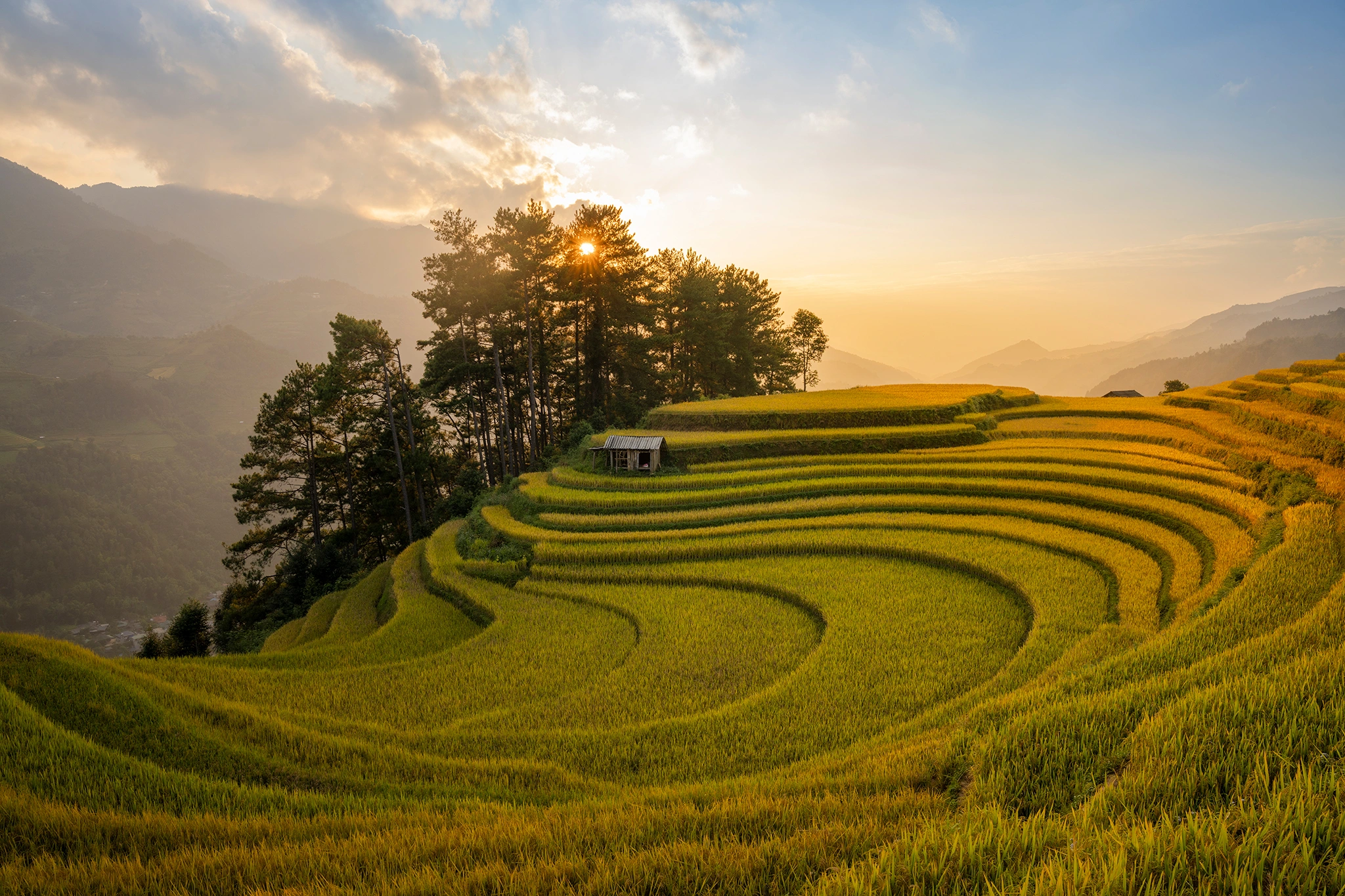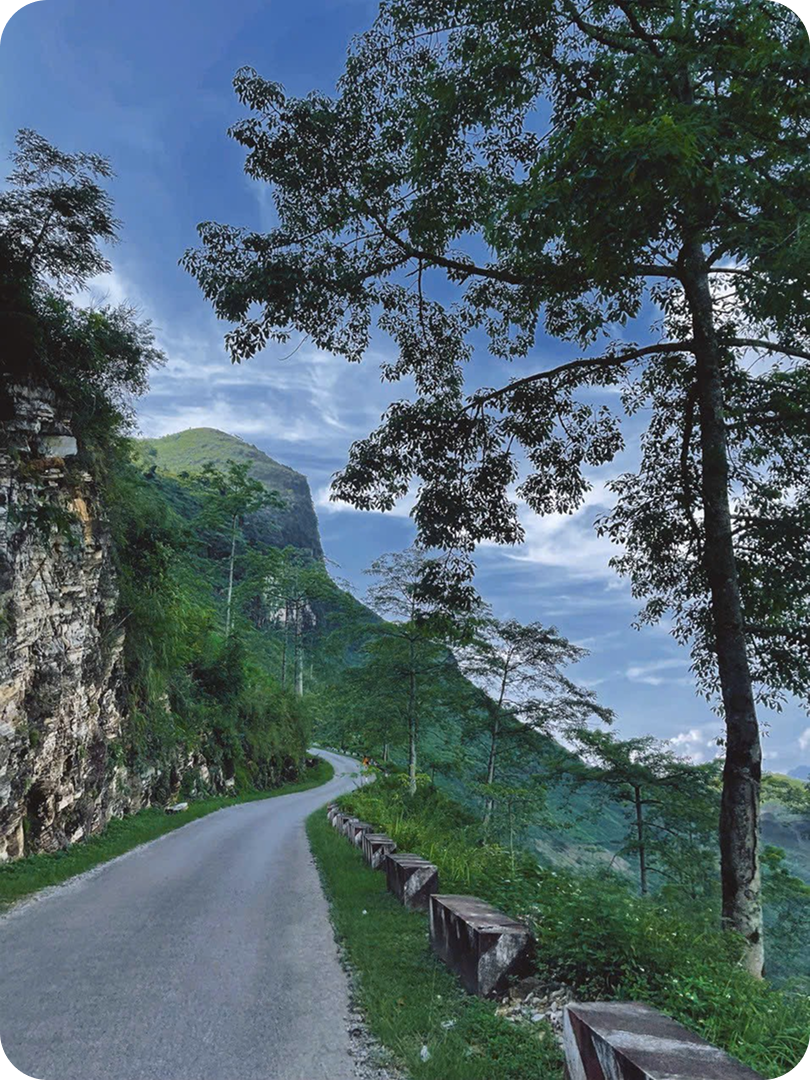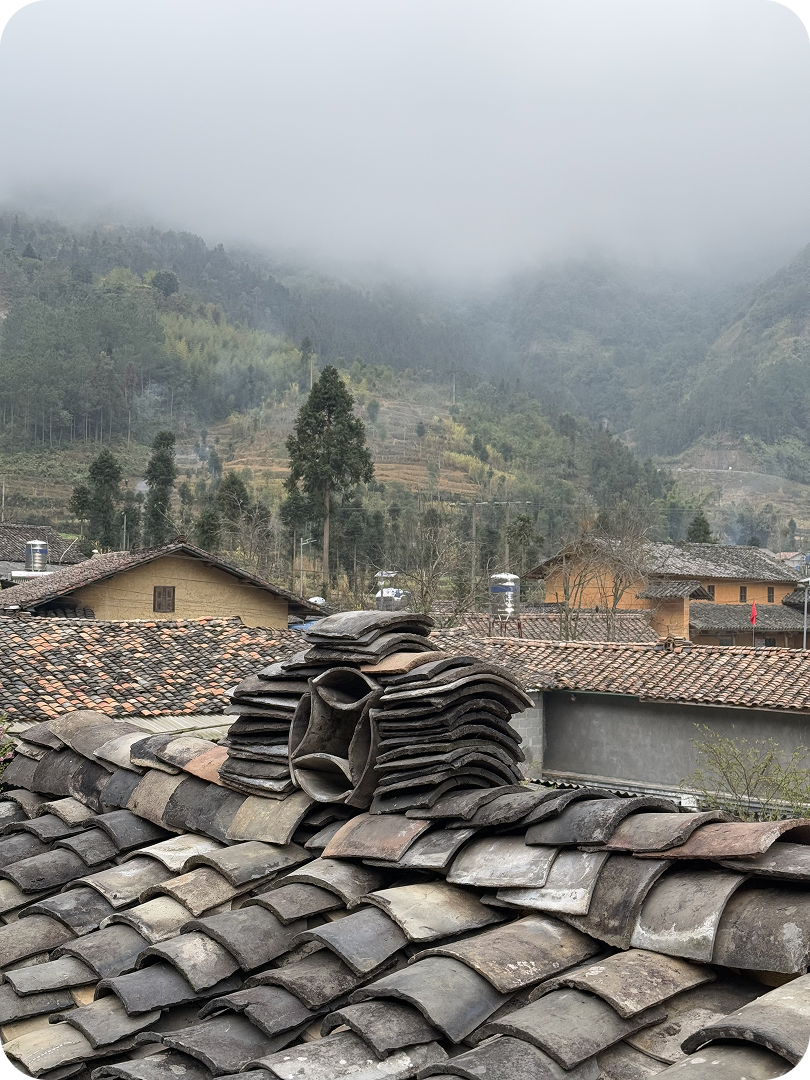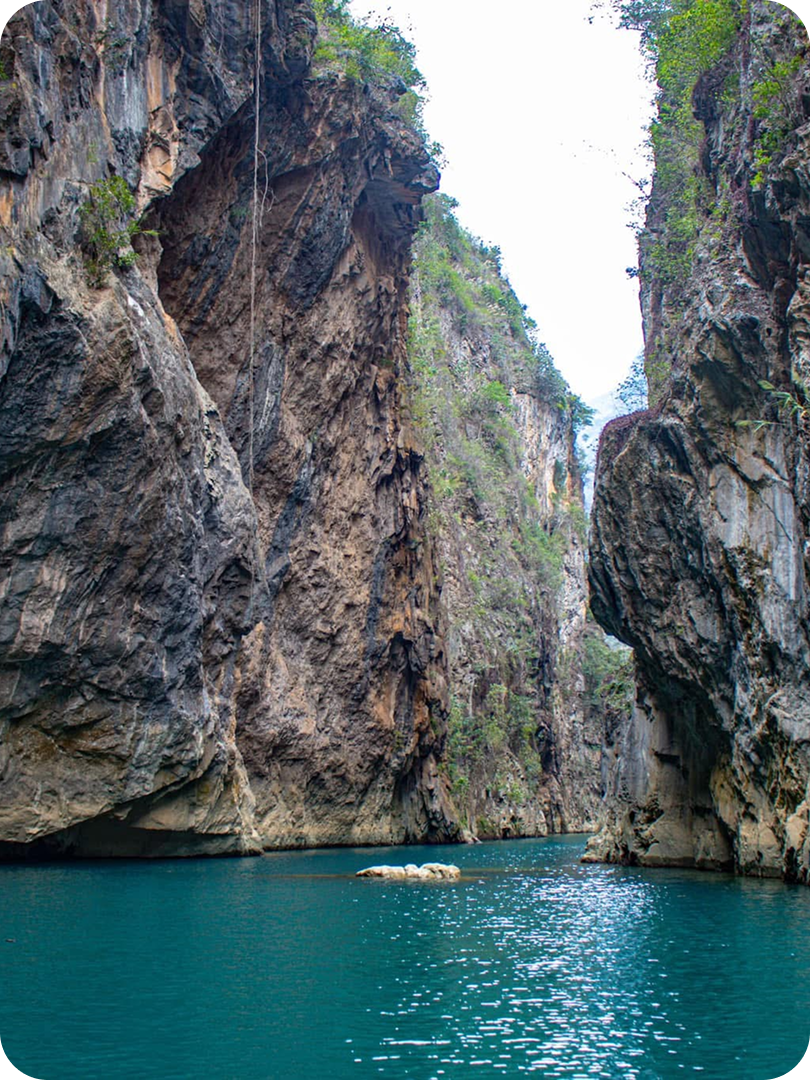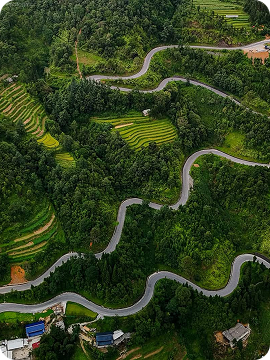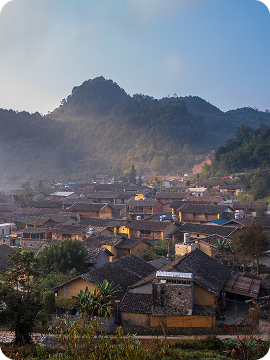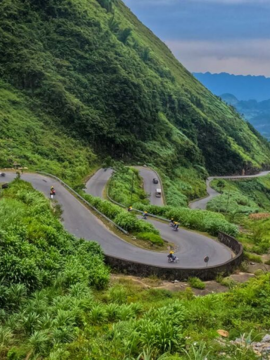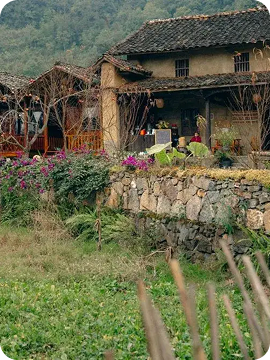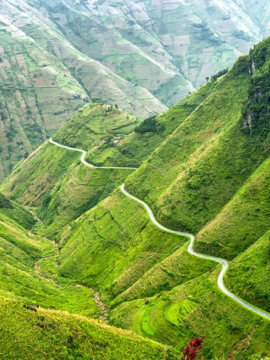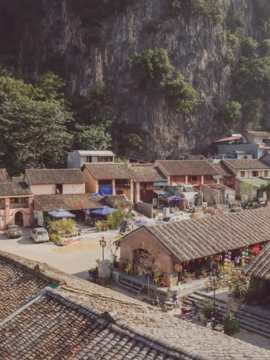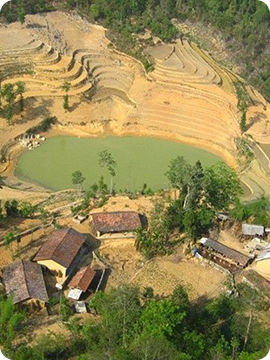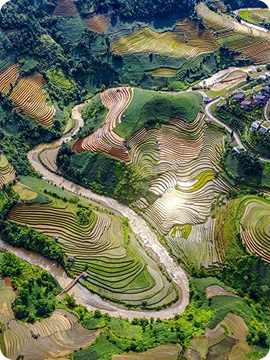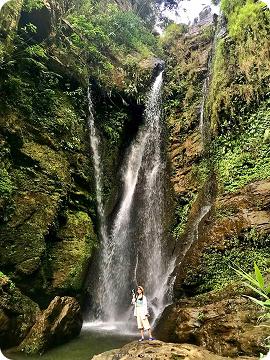 MU CANG CHAI – HA GIANG
MU CANG CHAI – HA GIANG
A breathtaking route of terraced fields and mountains.
When it comes to Vietnam’s most breathtaking golden rice terraces and stunning layered fields, Mu Cang Chai is always the first name that comes to mind. From La Pan Tan with its winding hillside roads embracing terraced fields, to peaceful Tu Le nestled in a rice valley, to Khau Pha Pass with its sea of white clouds – each destination offers something unique that attracts visitors from near and far.
If you’re planning a trip to this region, this guide from Phieu Travel will help you choose the ideal time to visit, suggest transportation options, recommend accommodations, and highlight unmissable experiences in Mu Cang Chai. Additionally, the final section offers suggestions for those looking to extend their journey Mu Cang Chai – Ha Giang to discover more of Vietnam’s stunning Northeast landscapes.
1. Where is Mu Cang Chai?
Mu Cang Chai is a highland district located in western Yen Bai province, more than 300km northwest of Hanoi. This area sits at an elevation of over 2000m above sea level, nestled at the foot of the majestic Hoang Lien Son mountain range, surrounded by rolling mountain ranges and deep green forests.
The journey to Mu Cang Chai is an adventure in itself for exploration enthusiasts. The road winds through deep valleys, steep hillsides, and twisting mountain passes stretching from Nghia Lo to the summit of Khau Pha Pass. Each curve reveals a new landscape, from the vast Muong Lo rice fields to mist-covered mountain slopes.
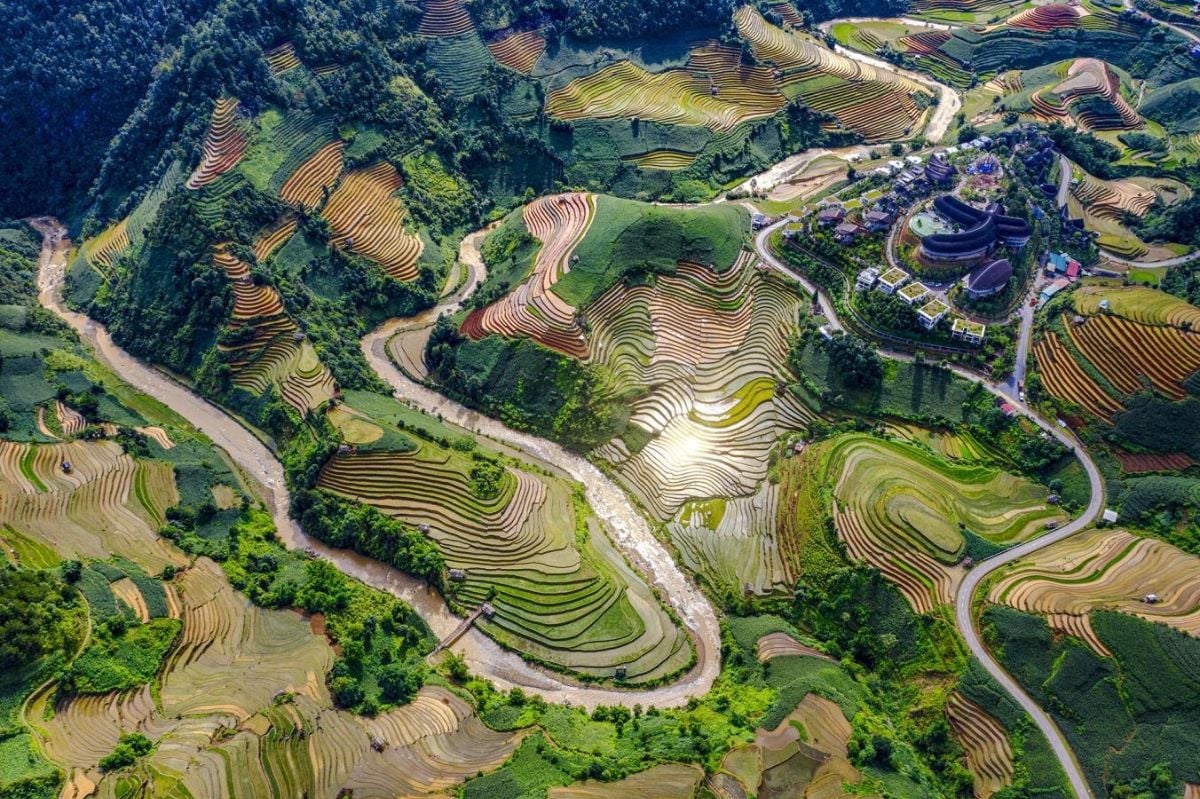
The climate in Mu Cang Chai changes throughout the day. Early mornings bring thick fog covering the hillsides and a thin white layer over wooden rooftops. By midday, gentle sunlight filters through the trees, illuminating the footpaths. As evening approaches, the air cools, clouds drift slowly across the mountain passes and wrap around consecutive mountain ranges.
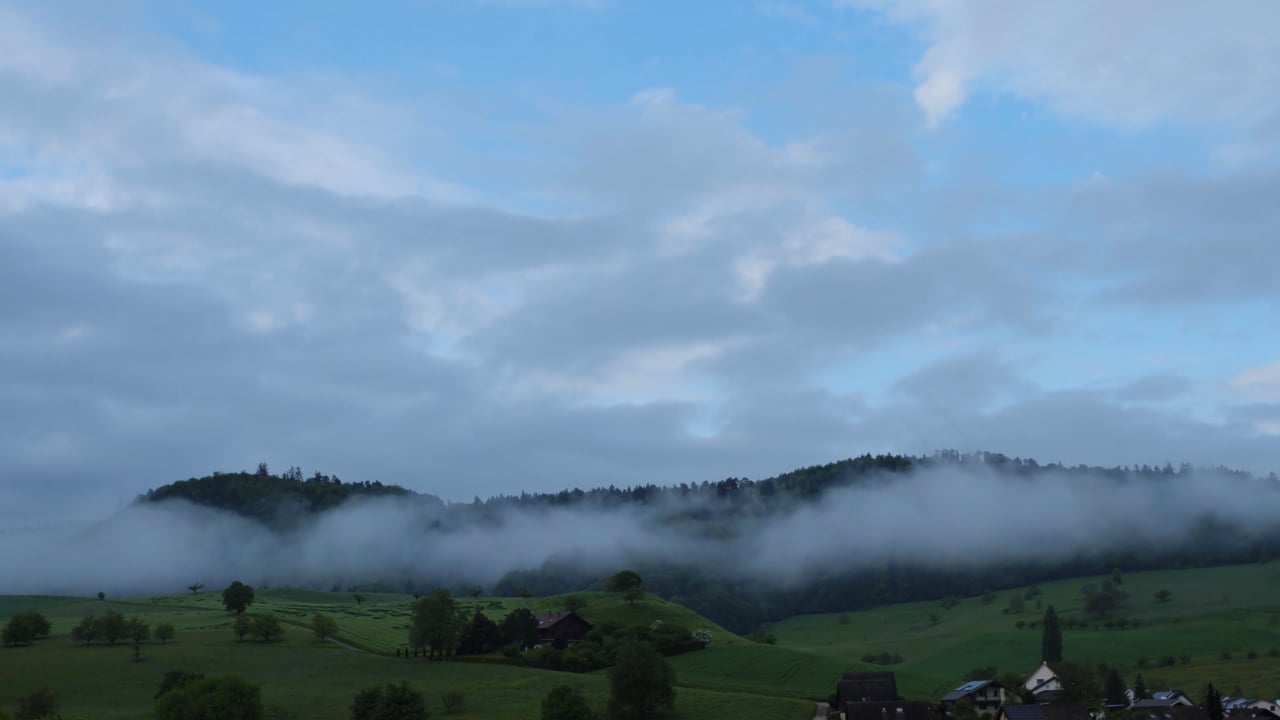
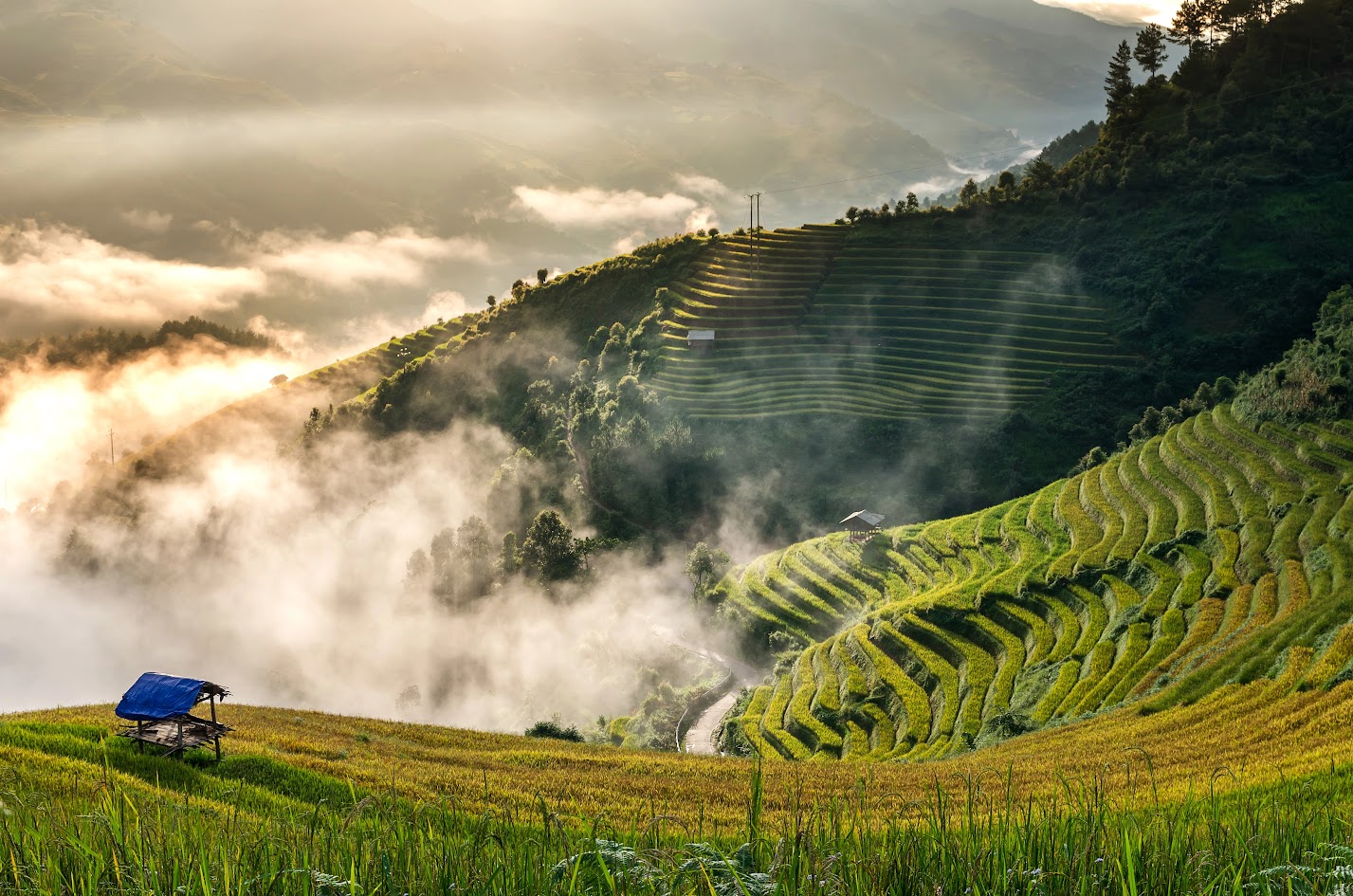
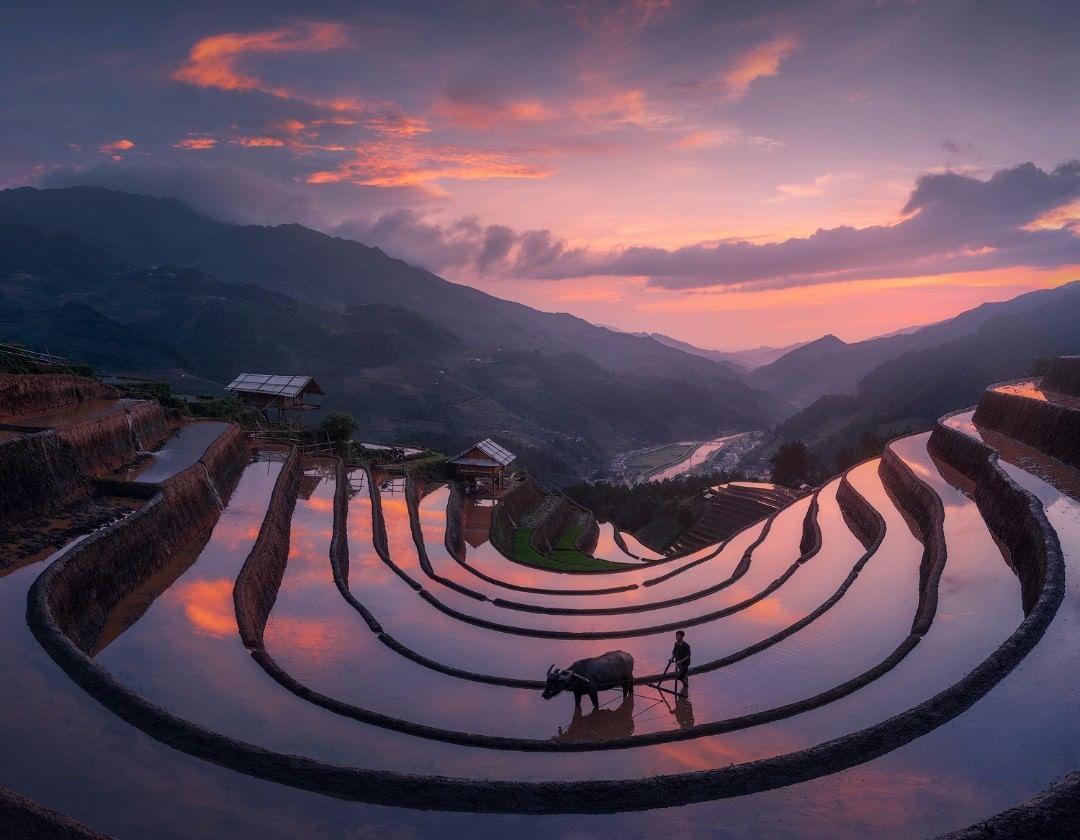
The mountainous terrain is distinctly layered, with ranges stretching to the horizon. From a distance, the nearest mountains appear deep green, while farther ranges fade gradually into thin mist. White clouds drift across the slopes, slowly winding around the terrain like silk ribbons suspended in mid-air. The entire panorama opens up expansively, showcasing pristine natural beauty that perfectly embodies what people imagine when they think of Vietnam’s Northwest region.
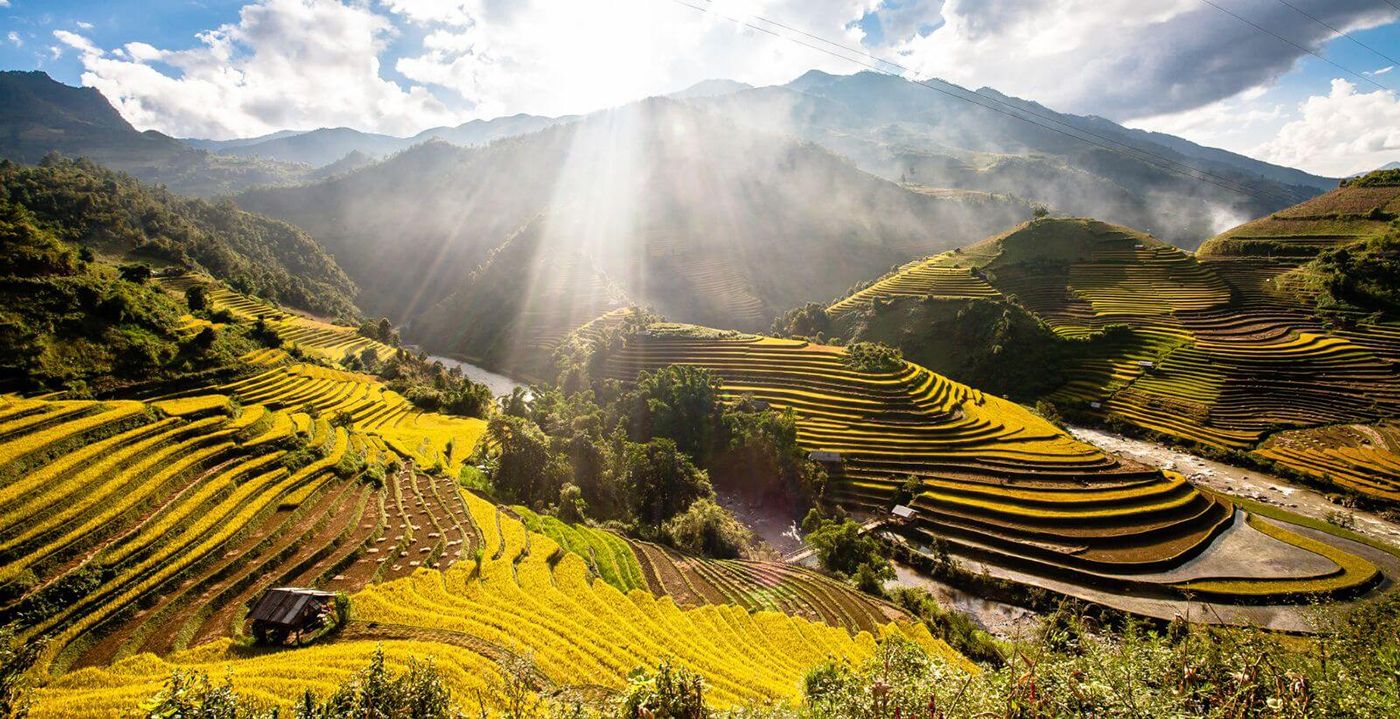
2. When is the best time to visit Mu Cang Chai?
The most beautiful times to visit Mu Cang Chai are during the water-pouring season (May-June) and the rice harvest season (September-October).
In May and June, water flows down from the mountaintops through small streams, filling each level of the terraced fields. The water’s surface glistens, reflecting the sky’s color, dotted with the fresh green of newly planted rice seedlings. The entire hillside seems to awaken after the dry season, with a cool, peaceful atmosphere.
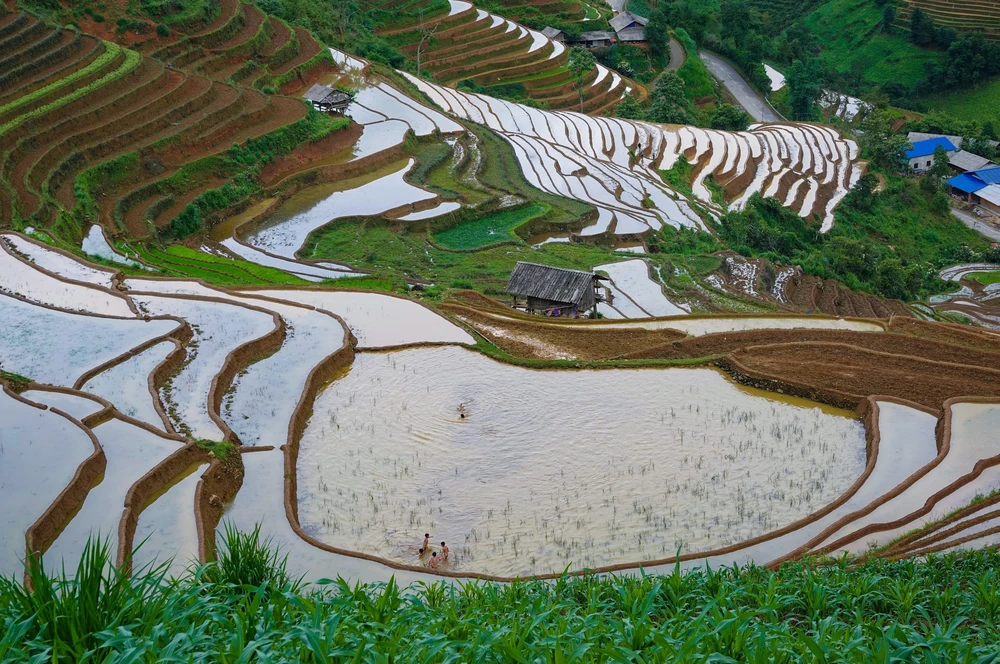
By September and October, Mu Cang Chai enters its most radiant golden season of the year. The terraced rice fields curve around mountain slopes, dyed with ripening rice colors, extending as far as the eye can see to the horizon. This is also when photographers and travel enthusiasts flock to the region, hoping to capture moments of the harvest season in Vietnam’s Northwest landscape.
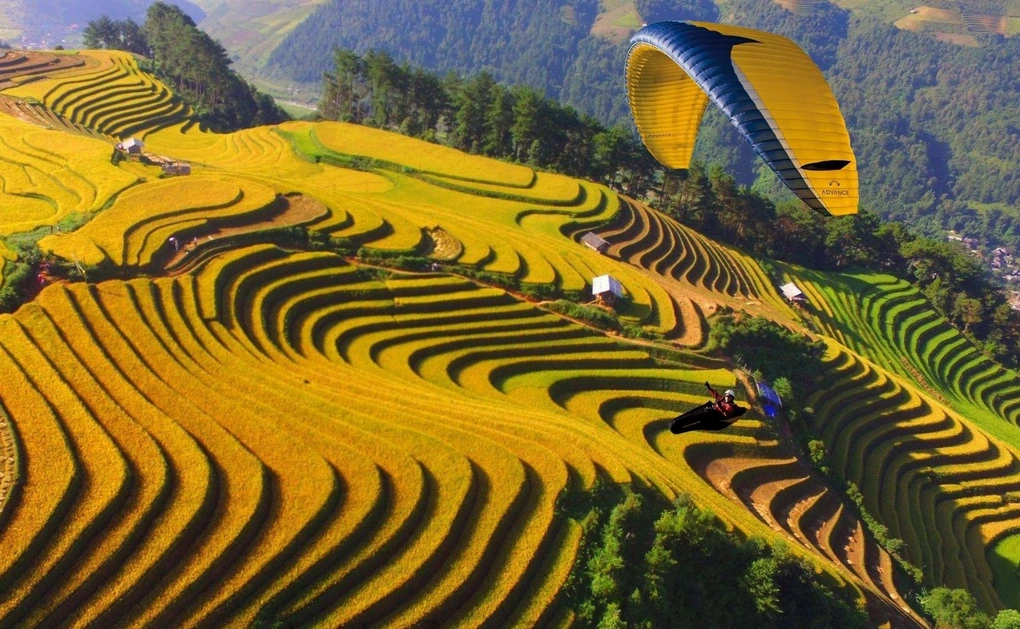
3. How to get to Mu Cang Chai
To travel from Hanoi to Mu Cang Chai, you have the following transportation options:
By Bus
Buses to Mu Cang Chai depart daily from My Dinh station in Hanoi. Most routes pass through Nghia Lo – a famous stop known for its vast Muong Lo rice field. Some bus companies choose to take the Noi Bai – Lao Cai expressway for the first segment, then merge onto National Highway 32 to continue upward into the mountains.
By Private Car or Motorcycle
The easiest route is along National Highway 32. Departing from Hanoi, follow the direction of Nhon – Son Tay, cross Trung Ha Bridge, then proceed through Thanh Thuy, Thanh Son (Phu Tho), Tan Son, and Thu Cuc. From there, continue toward Van Chan, through Nghia Lo, to Tu Le. After crossing Khau Pha Pass, you’ll reach Mu Cang Chai town. The total travel time is 7 to 8 hours, depending on weather and traffic conditions.
Once you’ve arrived in Mu Cang Chai, renting a motorcycle is recommended to explore the scenic routes and famous attractions in the area. Rental prices range from 150,000 to 200,000 VND per day. Be sure to carefully check the brakes, tires, and lights before deciding to rent!
4. What to experience in Mu Cang Chai?
When visiting Mu Cang Chai, don’t miss these fascinating destinations:
4.1 Khau Pha Pass – One of Vietnam’s “Four Great Mountain Passes”
Khau Pha Pass is located on National Highway 32, connecting Tu Le and Mu Cang Chai town. With an elevation of over 1200 meters above sea level and a length of nearly 30 km, it’s one of the most challenging and beautiful mountain passes in Northwest Vietnam.
Khau Pha is famous for its consecutive hairpin turns. One side features sheer mountain walls, while the other overlooks deep abysses. The steep road with sharp curves demands drivers to be experienced with mountain roads and have steady control. If riding a motorcycle, you should plan to start in the morning, avoiding times of thick fog or after rain to ensure safety.
Standing at the summit, you can gaze across the magnificent Northwestern mountains and forests. In the morning, white clouds drift across the mountainsides, covering the slopes with a thin mist, creating a scene that’s both majestic and dreamy. During the rice harvest season, Tu Le Valley appears below in brilliant gold, with layers of terraced fields curving like golden ribbons embracing the mountain base.

4.2 Admiring the majestic rice fields in Tu Le commune
Tu Le is a small commune in Van Chan district, situated right on the route from Nghia Lo to Mu Cang Chai. It’s primarily home to Thai ethnic people, notable for their stilt houses nestled against hillsides and the vast Muong Lo rice fields.
During each harvest season, Tu Le dresses itself in brilliant gold. The terraced rice fields curve gently, layer upon layer embracing the valley. In the morning, thin mist spreads across the fields, while a gentle breeze carries the fragrance of ripening rice. In this setting, you’ll often encounter Thai women in black skirts, with fair rosy skin and gentle smiles, walking slowly along the small dirt paths.
Beyond the golden scenery, the festive atmosphere of village celebrations in September-October adds vibrancy to Tu Le. The sound of khene pipes echoes from the hillsides, xoe dance circles form in village courtyards, and the aroma of fresh young rice cakes fills the air – all blending together to create a Tu Le that is both peaceful and full of life.
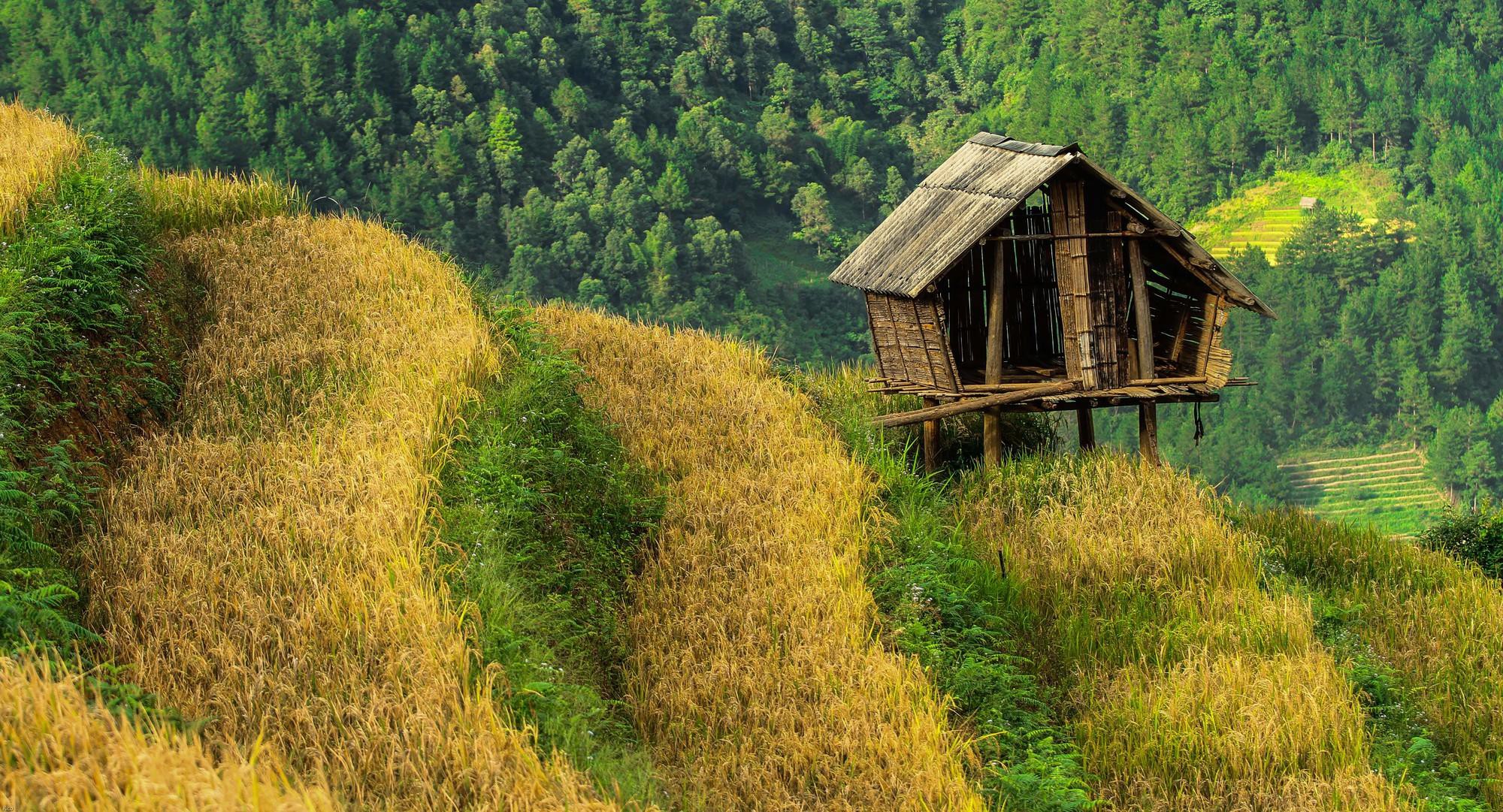
4.3 Relaxing at Mo Waterfall
Mo Waterfall is situated between the hills of Na Hang A and Na Hang B in Mo De commune, Mu Cang Chai. Amid lush green forest scenery, water cascades from above, rushing over rock formations and creating white foam. The sound of the waterfall blends with rustling forest leaves, giving travelers a refreshing, pleasant sensation.
In summer, the air around Mo Waterfall is surprisingly cool. Standing at the base of the falls, mist sprays onto your face and through your hair, seemingly dissolving the heat. Many people choose to stop here, sitting on large rocks, dangling their feet in the cool water while listening to the waterfall’s sound harmonizing with forest noises. Some fruit brought along, a few lively conversations among friends – enough to let the afternoon pass by peacefully.
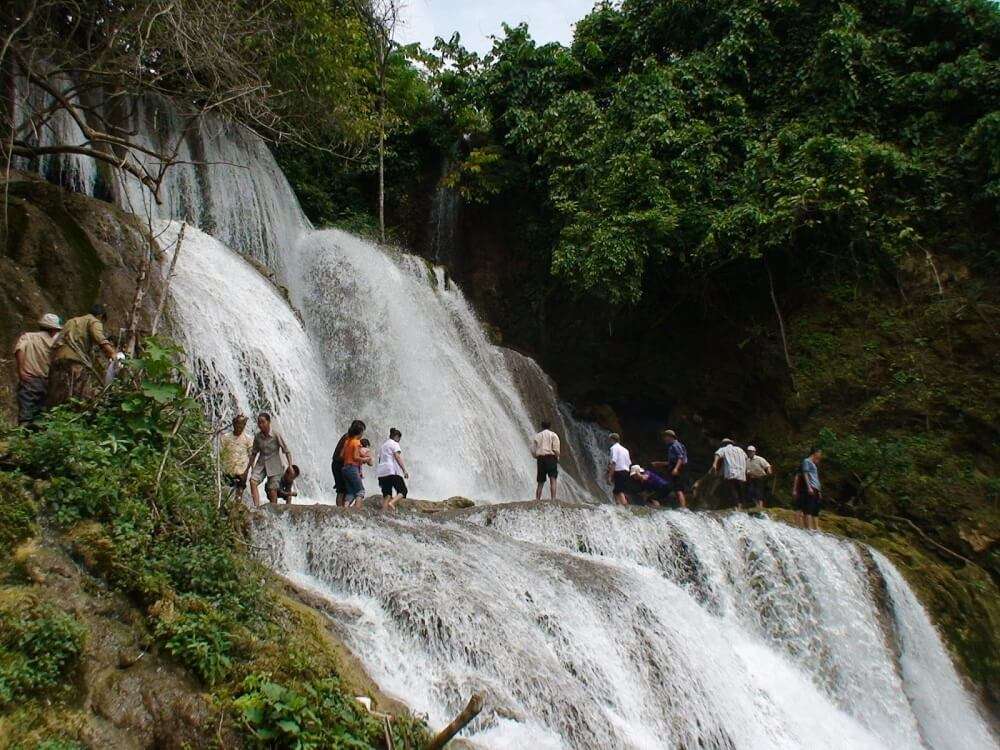
4.4 Trekking in Mu Cang Chai’s bamboo forest
Mu Cang Chai’s bamboo forest is located in Na Hang Tua Chu, Pung Luong commune, about 20km from the district center. The path to the forest isn’t long but has many steep and winding sections. The deeper you go, the gentler the air becomes, with coolness seeping through your clothes. The damp earth mingled with forest leaf scent creates a familiar earthy aroma, giving you the feeling of entering a lush green world just awakening after night rain.
Unexpectedly, after a curve, the bamboo forest appears with perfectly straight bamboo trunks spreading across more than 1 hectare. Light filters through the leaves, creating dappled patterns on the ground, forming a peaceful, pristine atmosphere.
Many say that standing in Mu Cang Chai’s bamboo forest easily evokes the feeling of being lost in a historical film scene. Simply raising your camera, without much adjustment, is enough to capture a truly authentic image. But perhaps what lingers longest is the light-hearted feeling in your heart after taking a deep breath amid the rustling bamboo forest.
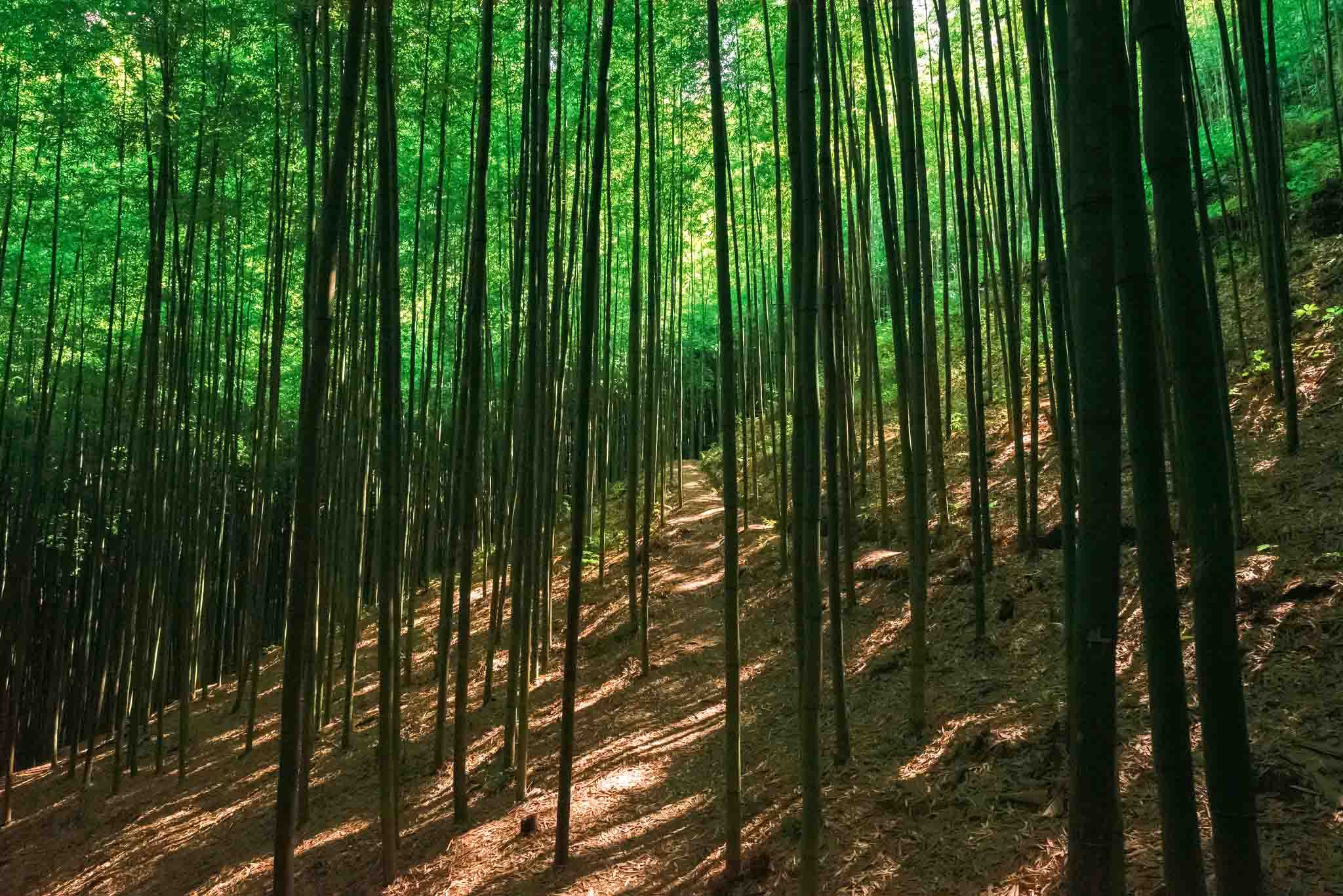
4 Days 3 Nights Ha Giang Loop tour: Slow down, see more, feel more
5. Where to stay in Mu Cang Chai?
In Mu Cang Chai, community stilt houses are the most popular accommodation choice. These are simple wooden houses located at the foot of mountains, near places like La Pan Tan, Tu Le, or Thai villages. Rooms are typically dormitory-style, with space for 10 to 30 people. At the base of the house, the kitchen area always has a warm fire, and nearby is a small convenience store with basic necessities.
If you prefer more peaceful spaces, you can choose separate homestays like Do Gu Homestay in La Pan Tan or Ngoc Thuy Homestay. Each place maintains a rustic, approachable charm, with prices ranging from 100,000 to 700,000 VND per night.
For travelers seeking eco-friendly accommodations, ecolodges like Hello MCC or MCC Ecolodge are worth considering. If you need more amenities, you can stay at 1 to 3-star hotels right in Mu Cang Chai town, or travel to Tu Le and Nghia Lo for a wider range of quality accommodation options.
6. Exploring the Mu Cang Chai – Ha Giang route
Many travelers often combine Mu Cang Chai and Ha Giang in a single extended journey to fully experience the transitional beauty from the Northwest to the Northeast regions. From the golden terraced rice fields of Mu Cang Chai, the route gradually extends through forests and mountains, crossing Khau Pha Pass toward Ha Giang’s gray karst landscape. Each section of road offers changing scenery, from soft golden hues to towering rocky peaks.
The route spans approximately 200km with many steep passes and sharp turns, but in return offers countless memorable landscapes. In the morning, you might stand amid the Northwest’s sea of clouds, and by evening find yourself amidst Dong Van’s rocky plateau. Curves hug mountain slopes, one slope follows another, valleys and mountains extend continuously to the horizon.

6.1 Exploring the Ha Giang Leg: Discovering the Nation’s Frontier Land
After bidding farewell to the golden terraced fields of Mu Cang Chai, the journey continues to Ha Giang—a completely different world defined by a gray karst plateau, the most treacherous mountain passes, and villages perched on the edge of cliffs. This is a challenging yet emotional leg of the journey, where you will fully experience the majesty of Vietnam’s frontier land.
6.1.1 Must-See Destinations in Ha Giang
The Ha Giang leg of your journey will take you through legendary landscapes. Here are the most important stops:
- Dong Van Karst Plateau: Recognized as a UNESCO Global Geopark, this entire area is a massive geological museum featuring limestone mountain ranges formed over millions of years. The scenery is constantly changing, both wild and magnificent.
- Ma Pi Leng Pass & Nho Que River: Dubbed the “king of all passes,” Ma Pi Leng is a breathtakingly treacherous road with a sheer cliff on one side and a deep abyss on the other, overlooking the emerald-green Nho Que River below. Standing at the summit to gaze at the winding river is a life-changing experience.
- Lung Cu Flag Tower: The sacred northernmost point of Vietnam. The journey to the top of the tower to watch the red flag with a golden star fly proudly amidst the clouds is an incredibly proud and moving moment.
- Vuong Family Mansion (King of the Hmong’s Palace): A unique architectural masterpiece blending Chinese, French, and Hmong styles. This ancient mansion, nestled in the Sa Phin valley, tells the story of a turbulent historical period under the “King of the Hmong,” Vuong Chinh Duc.
- Dong Van Old Town: Home to ancient houses with yin-yang tiled roofs that are hundreds of years old, nestled at the foot of rocky mountains. During market days, the old town comes alive with the colorful brocade of Hmong, Dao, and Tay ethnic groups.
Explore Deeper: To learn more about all the destinations on the Ha Giang journey in greater detail, you can read our comprehensive Guide to the Ha Giang Loop here.
6.1.2 Must-Try Specialties in Ha Giang
Ha Giang’s cuisine offers unique mountain flavors that are sure to surprise you:
- Thang Co: The most iconic dish of the Hmong people, a type of hotpot made from the meat and offal of horses (or cows/buffalos), eaten with wild vegetables and a special chili salt dip.
- Au Tau Porridge (Chao Au Tau): A porridge with an initially bitter but ultimately sweet and nutty aftertaste, cooked from the Au Tau root, glutinous rice, and pork knuckle. It is known for its medicinal properties, helping to relieve colds.
- Dong Van Steamed Rice Rolls with Egg (Banh Cuon Trung): A thin steamed rice sheet with an egg cracked inside and cooked until just right, served with a clear, sweet broth made from pork bones.
- Thang Den: A dessert similar to glutinous rice balls (mochi), served in a hot, sweet ginger syrup. It’s the perfect treat for Ha Giang’s cool weather.
6.1.3 Where to Stay in Ha Giang
- Village Homestays: The top choice for a cultural experience. You can stay in traditional earthen-walled houses of the Hmong people in Dong Van and Meo Vac, or in the villages of the Dao and Tay communities.
- Hotels/Guesthouses in Town Centers: In major towns like Dong Van and Meo Vac, you’ll find more hotels and guesthouses with modern amenities if you prefer more comfort.
6.2 Suggested Itineraries for the Full Mu Cang Chai – Ha Giang Route
Here are two suggested itineraries for you to consider for this epic journey.
6.2.1 5-Day, 4-Night Itinerary (Fast-Paced & Key Highlights)
- Day 1: Hanoi – Nghia Lo – Mu Cang Chai. Depart early, have lunch in Nghia Lo. Arrive in Mu Cang Chai in the afternoon, visit Khau Pha Pass and Tu Le valley. Overnight in Mu Cang Chai.
- Day 2: Explore Mu Cang Chai – Travel to Ha Giang. In the morning, explore La Pan Tan or Mo Waterfall. After lunch, begin the long journey to Ha Giang City. Overnight in Ha Giang City to rest.
- Day 3: Ha Giang – Quan Ba – Dong Van. Start the “Ha Giang Loop.” Stop at Quan Ba Heaven’s Gate, the Twin Mountains, and have lunch in Yen Minh. In the afternoon, visit the Vuong Family Mansion. Overnight in Dong Van.
- Day 4: Dong Van – Ma Pi Leng – Meo Vac – Ha Giang City. An early start for Lung Cu Flag Tower (optional). Conquer Ma Pi Leng Pass, take a boat on the Nho Que River (if time permits). Return to Ha Giang City via the Meo Vac – Yen Minh route. Overnight in Ha Giang City.
- Day 5: Ha Giang City – Hanoi. After breakfast, depart for Hanoi, concluding the journey.
6.2.2 7-Day, 6-Night Itinerary (Leisurely & In-Depth Exploration)
- Day 1: Hanoi – Mu Cang Chai. Travel and check in. Enjoy a leisurely afternoon watching the sunset over Khau Pha Pass.
- Day 2: Fully Explore Mu Cang Chai. Spend the whole day visiting deeper into villages like La Pan Tan and Che Cu Nha, trekking through the bamboo forest, or relaxing at Mo Waterfall.
- Day 3: Mu Cang Chai – Hoang Su Phi – Ha Giang City. Instead of the direct route, take the scenic road through Hoang Su Phi (if it’s the rice season) to admire more spectacular terraced fields before arriving in Ha Giang City.
- Day 4: Ha Giang – Quan Ba – Yen Minh – Dong Van. Begin the journey on the karst plateau. Stop frequently for photos and to enjoy the views. Overnight in Dong Van Old Town.
- Day 5: Dong Van – Lung Cu – Ma Pi Leng – Meo Vac. Dedicate the morning to Lung Cu Flag Tower and the Vuong Family Mansion. In the afternoon, conquer Ma Pi Leng Pass. Overnight in Meo Vac.
- Day 6: Meo Vac – Du Gia – Ha Giang City. Take the less-traveled Meo Vac – Du Gia route to experience its wild, pristine beauty before returning to Ha Giang City.
- Day 7: Ha Giang City – Hanoi. Relax, shop for local specialties, and return to Hanoi.
If you’re planning a Mu Cang Chai – Ha Giang journey, take time to arrange a detailed itinerary. The road is long with many steep mountain passes, and each landscape has its own best viewing time, so don’t miss opportunities to stop and admire the views. Before departure, check your brakes, lights, and tires to ensure your vehicle runs smoothly! For the Ha Giang segment, if you want a deeper experience, consider checking out Phieu Travel’s tours!
You Might Also Like:
- Conquering the Chin Khoanh Ramp – An Adventure Journey in Ha Giang
- Dragon Mountain-Dragon Eye in Ha Giang: The Ultimate Guide
- Discover the Charm of Du Gia: A Hidden Gem in Ha Giang


